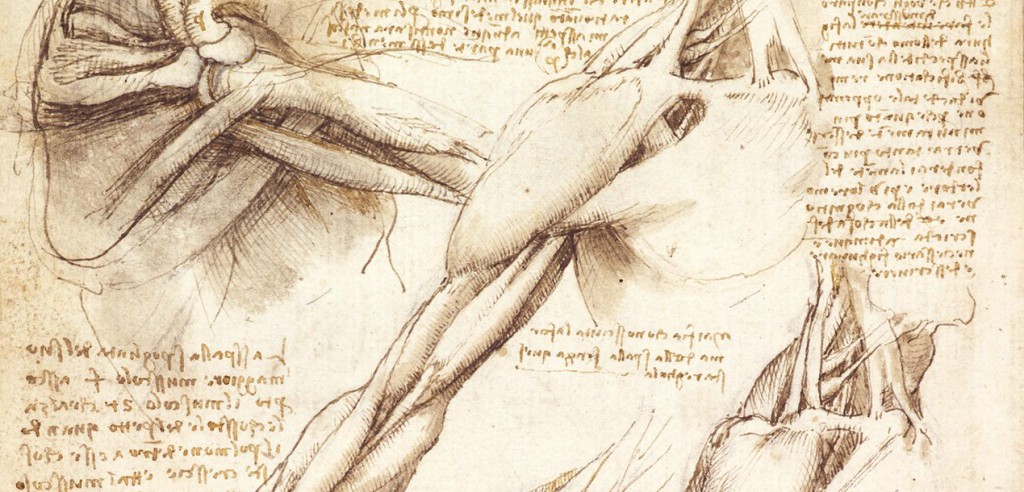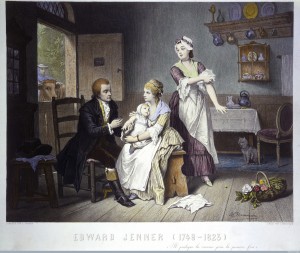In Carrie Mae Weems’ series, “From Here I Saw What Happened and I Cried,” Weems uses appropriation to modify the images taken by J.T. Zealy. Having seen one of the photographs of J.T. Zealy’s titled Jack from the 1850’s, I had an idea where this set of artwork was leaning towards. It portrays sadness, darkness, helplessness and focuses around a ‘scientific subject’, which happened to be slaves during that era. In Weems’ series, her appropriation shows more than just a picture but rather instills a story behind it. She changes the color scheme from black and white to a deep red that makes the images look more powerful. Her use of the color red deeply captures the attention of the audience. As far as being able to read the text while observing the image, I feel that it can be done. The text serves to enhance the experience and gives the viewer something to think about while looking at the work. Without the text, the images may seem mysterious but may also give the viewer slightly more freedom to ponder what the subject may have been feeling when the image was taken. It may be more open to differing opinions without the text. However, with the knowledge that this took place in the 1800’s, we cannot overlook the discrimination and racism that happened during this time. I think Weems’ photographic project went outside the box and captured what I feel these subjects in the picture are feeling. She delivers short powerful messages with a bit of empowerment.
Category Archives: Homework
Homework #2
Prior to watching the video, I looked at the photographs from her series “From Here I Saw What Happened and I Cried” in order on Carrie Mae Weems’ website. My first impression was a mixture of feeling angered and disturbed by the images. But I also felt that the series of photographs were meant to stir up those kinds of feelings. Carrie Mae Weems’ intention seems to build on exposing the mistreatment and history of dehumanization and discrimination over time. These people in the photographs were used as objects for study. These photos tell a story, one that is not intended to be pleasant, but rather complex and powerful. It narrates the development of history and functions as a film through time. Both the words and the photographs intertwined and created an emotional impact. After watching the short video, I can see how the color contrasts the original photograph. With the technique of using monochrome red, these photographs are enhanced and speak loud to the audience. She describes these photos as “singular moments” that actually represent a much larger meaning and complex idea. These people were just used as sample pieces and stripped of their dignity. Looking at the photos alone already gives meaning to how these people were mistreated. The text gives the photographs a timeline and history, without the text the photographs gives the audience more room to have their own interpretation and imagination about what these photos mean. I felt that Weems’ project uses the photographs and text to tell us a very important history that developed over the course of several decades.
HW #2 Carrie Mae Weems on Race, Appropriation, and Photography
Louis Agassiz used Zealy’s photographs to study and support his theory of polygenesis. He seems not only divide black people from other color of races, but also He defines black people as slavery, no socialized, and no equalized person. However, Carrie Mae Weems used Zealy’s photographs in the opposite way from Louis Agassiz. The Photographs were recreated by Carrie Mae Weems through using the tool of appropriation. She putted texts on the images. Then, the photographs become arts and massages at the same time. She seems to claim the right of equality, freedom, and liberty of black people to public through her works.
People say “A picture is worth a thousand word” I think her work is a great way to deliver her message to public because the images with strong color tones and texts are impressive and attractive. The texts are helpful to read her intentions from her works. She emphasized how the people in photographs were used and classified by white people during taking the photographs at the time. People were naked and set up in front of the camera. They were treated as black thing, subject, and scientific profile because they were slave. Ironically, Carrie Mae Weems seems to succeed to use Zealy’s photographs in the opposite way what Louis Agassiz’s purpose to make the photographs.
Homework #2: Carrie Mae Weems on Race, Appropriation, and Photography
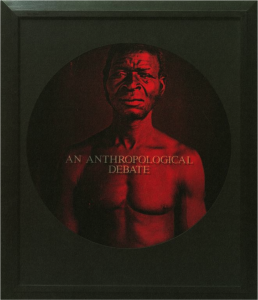
Carrie Mae Weems, “An Anthropological Debate” from “From Here I Saw What Happened and I Cried,” 1995-1996
In class we have studied J.T. Zealy’s daguerreotypes of slaves that were commissioned by Harvard scientist Louis Agassiz to support his belief in the theory of polygenesis. For this homework, please explore the works of contemporary artist Carrie Mae Weems, who uses the tool of appropriation to critique issues of race in her art. Appropriation is a popular practice for modern artists, who borrow and alter pre-existing images in order to transform and give images new significances. Weems appropriates many of Zealy’s photographs in her series “From Here I Saw What Happened and I Cried.” Listen to a brief statement about the series and explore the photographs in the series on her website. Reflect on your experience of reading the texts and looking at the images. Is it possible to do both at the same time? How would the work change without the text? What do you think of Weems’ photographic project?
Listen to Carrie Mae Weems on “From Here I Saw What Happened and I Cried”
Explore the “From Here I Saw What Happened and I Cried” series here
Please submit your post by class on Tuesday October 6th.
Homework #1

The image I chose was of a woman holding a young boy receiving an injection. The people in the picture look like they are at home in their living room. The family doctor has stopped by to give the child the shot. The young boy is sitting on it’s mother’s lap while the doctor inoculates the child. Two other children look on at the doctor. A boy looks on while holding the back of the doctor’s chair. A girl looks on from the other side of the doctor and holds a basket behind her back. The artist uses tenebroso in this picture. The background surrounding the people is dark while a strong light shines in on this family and doctor. You can’t make out the surrounding objects in the far background. To the side of the people is a child’s crib. I chose this picture because vaccinations happen to be a very important part of living. In earlier times, things were done differently. Instead of people traveling to a doctor’s office to receive care, doctor’s would travel to their patient’s home. In this instance, the doctor has traveled to this family’s home. He could be there to administer medication to the child because he was sick or they were trying to prevent sickness. The children and mother all look on in awe.
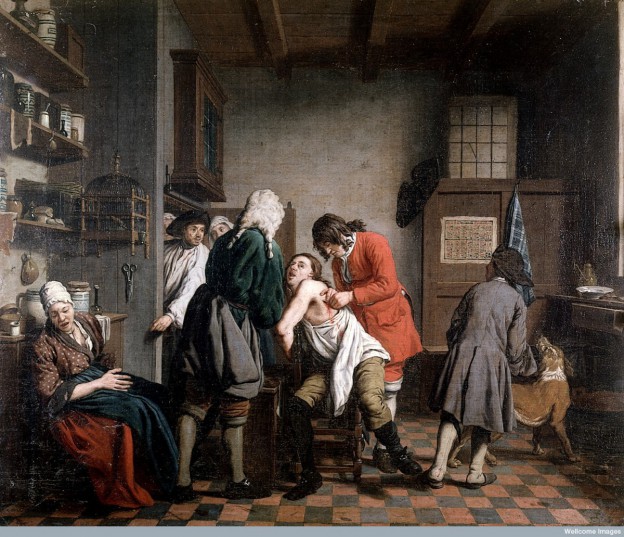
Homework #1 Michael Estrada
What I have found striking of this image was , how the patience in this image is being treated. it reflects how medicine has been improved over time. It got my attention because this image shows someone having a surgery . I think it was a common act where the surgeon did not have a specific place where to do this surgery or the patient could go like a hospital or a right place to do the surgery. We can also see the lack of hygiene during a clinical surgery, as we see there is a dog being walking around which might represent the lack of cleanliness and a mother or wife who suffers of pain more than a man who is being treated maybe with no anesthesia at all . It also shows a surgeon with no glove or special tools for doing a well surgical process as now days. I am seeing someone putting its own hand in a open wound trying to move or find something inside the patient. This image shows same contrast, feelings and reality as the images seen in class. through this master piece of drawing we can see how the history of medicine has been improved since long time ago where there was no camera of any relating media as there are plenty of them today.
Eleana Zeng – Homework #1: Wellcome Images
The image that I chose from Wellcome Images is called “A Chinese lady (Lo Wanshun) from Canton (Guangzhou) sitting on a couch with a tumor on her left cheek.” This portrait was painted by Lam Qua in 1836.
This image captured my attention because the size of the tumor on the woman’s left cheek stood out to me. The tumor is situated beneath her left ear and it extends forward to her cheeks and nose and goes down to her neck. The woman is sitting gracefully on the wooden bench with both hands on her lap and her legs crossed. She is wearing a blue robe with black collars and a purple skirt. Her foot seems to be bound based on the shape and the type of shoe she was wearing. Her hair is put up into a simple hairdo with two hair ornaments sticking out from the back. She is wearing a jade bangle on both her wrists and a dangle earring on her right ear. Based on her appearance, it seems like she is in her late 30s to early 40s and she should be married and has children.
To me, the striking part of this image is the woman’s expression. Although the left side of her face is disfigured, she doesn’t seem all that sad. Her eyes show tiredness but she has a slight smile for the portrait. Perhaps she has hope that she will receive the right treatment for her tumor at Canton Hospital. This image is very similar to the image we saw in class where two sisters has a deformity in their left eye. Both images depict a physical deformity as a result of some disease or medical condition.

L0037319 Credit: Wellcome Library, London
A Chinese lady (Lo Wanshun) from Canton (Guangzhou) sitting on a couch with a tumour on her left cheek.
Homework #1: Wellcome Images Database
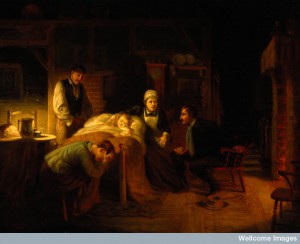
V0017575 “Anxious moments”: a sick child, its grieving parents, a nur
Credit: Wellcome Library, London. Wellcome Images
images@wellcome.ac.uk
http://wellcomeimages.org
“Anxious moments”: a sick child, its grieving parents, a nursemaid and a medical practitioner. Oil painting attributed to John Whitehead Walton, 1894.
By: John Whitehead WaltonPublished: –
Copyrighted work available under Creative Commons Attribution only licence CC BY 4.0 http://creativecommons.org/licenses/by/4.0/
The picture I chose is called “Anxious moments” it is an oil painting attributed to John Whitehead Walton from the year 1894. This painting depicts a scene of a sick child with her grief-stricken parents. A medical practitioner and a nursemaid are at the bedside.
This painting portrays mixed emotions. This painting takes place in the evening because there is a lamp at the bedside table and a glow from the door that looks like the sun is setting outside. The medical practitioner has rushed over and dropped his hat and cane on the floor. He is intent on assessing the child, while the parents are in obvious distress as they are trying to cope with the situation. The nursemaid has possibly given the child some medicine or water because she is holding a bottle while caressing the child and looking intently at the medical practitioner for further instructions. Based on the fact that this painting is from the 19th century, care is provided at home for children, I can assume that the family had no choice but to call the medical practitioner over to get the child checked. The mother is caring and cannot bear to look and see what could possibly be going wrong with her child. The father is patiently waiting and his expression is troubled and helpless, as he looks at the child in hopes that everything will be okay.
Focusing in on the child; she glows while her surroundings are dim. This gives the painting a feeling of innocence from the child. Her expression is peaceful and without any signs of distress. Despite the surroundings being so dark, looking solely at the child in the picture, it is uplifting. The child is neither suffering nor does it look like she has any form of severe illness.
The reason I found this particular painting striking is because it portrays the value of family and how medicine interacts with family ties. No matter how time goes on, whether it is the 19th century or the 21st century, the bond that families have will never change. Each individual in this picture represents the role that each title holds. When a child is sick, the entire family is involved with the healthcare providers. This compares to the imagery that we have discussed in class because it has a complimenting surroundings that reflect the central idea of the image. When we look at this painting we can see how colors, lighting, and facial expressions can give us so much meaning to the painting. It represents the knowledge and system of delivering care at the time the imagery was created. It speaks for itself as does the imagery we have discussed in class.
Homework 1
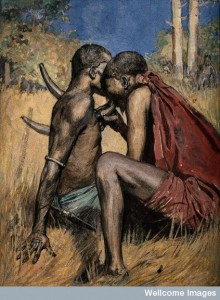
V0015962 An African medicine man or shaman applying the technique of
Credit: Wellcome Library, London. Wellcome Images
images@wellcome.ac.uk
http://wellcomeimages.org
An African medicine man or shaman applying the technique of cupping to a patient (using animal horns), which involves drawing blood to the surface of the body. Watercolour.
Published: –
Copyrighted work available under Creative Commons Attribution only licence CC BY 4.0 http://creativecommons.org/licenses/by/4.0/
This image depicts an African medicine man using the practice of cupping on a patient. This painting speaks to me because this is an ancient healing art that has transcended in to current Western use. Cupping is largely practiced in Chinese medicine, but it has dated back as early as 3000BC. It is believed to promote blood flow to heal muscle tension or pain in various areas.
Through heat or suction the skin is vacummed into a cup placed over the targeted area. In the image the healer is using what look to be a hollowed bone or horn of some sort and manually drawing the skin into it with his mouth. In modern use a rubber pump may be used in addition to silicone cups. The cups are then left in place for a short time before removing.
This is more of an alternative treatment to various ailments, so there is not a lot of research on its effectiveness
Homework #1: Wellcome Images Database
The title of the image I chose from Wellcome Images is “vaccinating his young child, held by Mrs. Jenn.” I infer this painting indicates how a child was vaccinated in 18th century because the title of the painting mention vaccination, and the painter’s name and life time were written on the bottom of the painting that Edward Jenner lived from 1749 to 1823.
If I compare this image to the other images what I saw in the class. This image has more positive feeling with bright colors than other images in the class. The inside house is not bright because the house does not have a light but sunshine from the window lights up the child. The men is probably a house owner and could be a doctor who attempt to inject vaccine to a child. I think Mrs. Jenn will be a woman who is holding a child, and a woman will be a maid who stand and roll up her sleeve. They look like an upper-middle class because the house looks like locate in the countryside. I can see that a men stands outside holding a cow, and a cat sits inside under a table. However, the man and woman who sit are well dressed. I also can see some fancy tea cups and pots in a tea cabinet and on the wall. A habit of a drinking tea is a symbol of rich people in 18th century. This image shows how people vaccinate their child in 18th century. There are no gloves, mask, and sterilizing instruments. It indicates that people have a lack of knowledge about hygiene.
The image captured my attention because I felt a positive feeling from this image. This image is involved a disease as other images but it shows how we can prevent a disease and lead a child to healthy life compare to other images what I saw in the class. I think many images what I saw in the class have negative points to disease. The images describes a disease as a pain, suffering, hopeless, and death with dark colors.
